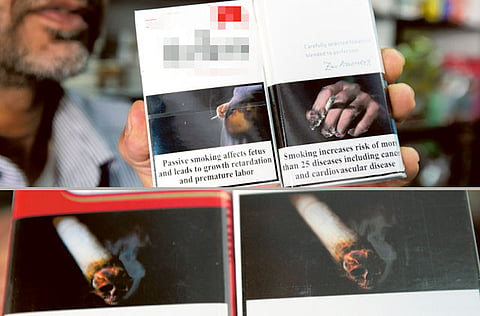Residents unconvinced about efficacy of graphic warnings
Residents not convinced about effectiveness of graphic warnings on cigarette packets

Abu Dhabi: Cigarette packs across the country have displayed graphic health warnings since the beginning of the year (2013), but few residents are convinced of their efficacy in dissuading smokers.
Authorities, however told Gulf News that even as packs without the mandatory warning are removed from retail shelves, further measures are already being considered to reduce the attractiveness of cigarettes.
“At present, the graphic health warnings cover about 50 per cent of each cigarette pack. At this size, they catch the human eye and are likely to be noticed. We are also studying the feasibility of plain packaging without apparent brand names, and working with other health entities to reduce the allowable amount of tar and nicotine per cigarette,” said Mohammad Saleh Badri, acting director general of the Emirates Standardisation and Metrology Authority (ESMA).
Three types of graphic warnings are currently being printed. One shows a burning and blackened hand holding a cigarette, while another depicts a lit cigarette with a skull emanating from it. The third depicts a pregnant woman, and how her unborn child is being harmed by the cigarette.
The ESMA not only ensures that cigarette packs contain the health warnings, but also tests cigarettes before sale to ensure that they contain only the allowable limit for each component.
“Since Wednesday (January 2), we have been coordinating with other government entities to ensure that all packs without the warnings are removed off shelves, especially as retailers and tobacco providers have been given a long period to comply with the decision,” Badri said.
“We are checking on the hypermarkets first, since nearly 80 per cent of all residents make most of their purchases there. Within the next two months, we expect that all packs without the warnings will have been phased out,” he added.
Residents, however, had mixed reactions about the effectiveness of the graphic warnings.
Nadine Berjawi, 31, a businesswoman and mother-of-two, said the graphic warnings were “better than nothing”.
“I feel that they are better than packs without warnings,” Berjawi said.
But another South Asian engineer in the capital, Mohamed M, said he was not convinced.
“I had imagined that the graphics would be bigger, and use more shocking pictures of unhealthy organs. I do not smoke myself, but I doubt the pictures currently being used will really discourage smoking,” he added.
Osama N., a 37-year-old banker from Jordan, had a similar opinion.
“I smoke when I feel the urge for a cigarette, and the presence of a graphic warning does not have any impact on this urge,” he said.
“The only way a smoker would really reduce or quit smoking is if he were fully committed,” Osama added.
Another smoker from Egypt said he had seen scarier graphic warnings on cigarette packs in Egypt, but that they too had had no real effect on when and how much he smoked.
When questioned, Dr Rasha Abbas, a consultant psychiatrist at the American Centre for Psychiatry and Neurology, said there is still not a lot of evidence to show the usefulness of graphic health warnings in reducing the number of smokers or frequency of smoking.
“However, a US-based study recently indicated that people are more able to recall graphic warnings than text warnings, and this can lend to their efficacy. In addition, they could also make smoking less attractive,” she explained.
The psychiatrist furthermore recommended more studies into the effect of these health warnings.
Sign up for the Daily Briefing
Get the latest news and updates straight to your inbox



